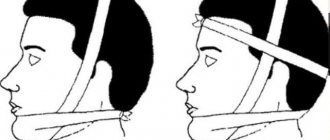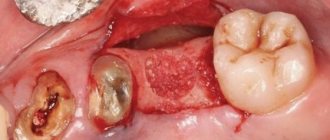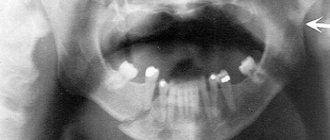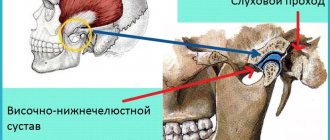Why does the lower jaw break?
Experts note that in the vast majority of clinical cases, pathology occurs due to injuries received in everyday life. These are falls, blows. You can get injured by slipping, doing physical activity and traumatic sports, or in active games (for children). The number of fights, domestic conflicts under the influence of alcohol and drugs, and road traffic accidents, due to which people suffer a broken jaw, as in the photo, are growing. Some people encounter problems with poor industrial safety on the shop floor, when working with heavy equipment and at heights.
This is what a mandibular fracture looks like
For many, it comes as a surprise that a fracture of the lower jaw can be caused by a number of dental and chronic diseases. As a rule, such trauma is caused by advanced pathologies, for example, a follicular cyst that has grown on the root of a tooth, or osteomyelitis. Oncological tumors, metabolic disorders and osteoporosis can also gradually destroy bone tissue, as a result of which the patient develops symptoms of a fracture.
According to statistics, young men (under 40 years of age) receive such injuries more often than women. The male sex tends to engage in dangerous sports, works in heavy industries, more often takes part in fights, and has a tendency to take risks and aggression.
Some researchers also argue that in rare cases, damage can occur during dental procedures, for example, during tooth extraction in case of extremely low qualifications of the doctor.
Can the upper jaw break?
Maybe, but doctors admit that this is a very rare situation. Due to anatomical features and lack of mobility, even in the most complex accidents, the upper jaw often remains intact. However, experts also emphasize that when the upper jaw is damaged, the symptoms and consequences are much stronger, they more often lead to death.
A fracture of the upper jaw is much more serious and dangerous than the lower jaw
The mandibular bone is massive and mobile, protrudes forward, therefore, with any external influence on it, it “suffers” first of all. According to statistics, it is damaged in 80% of cases of the total number of injuries to the bones of the facial skeleton.
Are fractures the same for everyone or are they always different?
Jaw fractures can be completely different, and it is impossible to independently determine which one you have. It all depends on the nature of the injury, the direction of the force, and the position of the person at the time of exposure to the traumatic factor. The diagnosis can only be made based on x-rays. Here are the main types and classifications of fractures:
- direct and indirect: in the first case, the area that was affected is directly injured. With an indirect injury, it is not the area of impact that is damaged, but the tissues located next to it,
- oblique, transverse, longitudinal: it all depends on the direction in which the fracture of the jaw bone will go,
- single and multiple: there can be only one fault, but most often there are many of them,
- large and small: if the bone is split into several fragments, then we are talking about a major fracture. If there are a lot of fragments and they are small, then doctors diagnose a minor fracture,
- one-sided and two-sided,
- open and closed: the first type involves damage not only to bone tissue, but to the mucous membrane, periodontal tissue, and teeth. The second type is much less common and only damages bone tissue.
Fractures can be different
Causes of damage
Many people think how hard it takes to break a jaw. In fact, even if you bite food incorrectly or close your jaws, you can injure them and, if the bone tissue is weakened, its integrity can be disrupted.
Main reasons:
- blows;
- injuries in athletes;
- falls;
- car crashes.
In some sports, only the teeth are protected from impacts. But the jaw, the bone tissue itself, is almost always defenseless. Even an unsuccessful fall can injure this bone.
How can you tell if a person has a broken jaw?
A person who has suffered such a serious injury experiences severe pain that radiates throughout the head. Due to the painful shock, you can lose consciousness or experience severe dizziness. Nausea and vomiting are possible. It becomes impossible to open or, conversely, close your mouth; accordingly, in this state you cannot chew, swallow, speak, and sometimes even breathe. Saliva and blood may involuntarily flow from the mouth.
It is visually noticeable that the lower jaw has shifted relative to the upper jaw, and facial asymmetry has appeared. The lower row of teeth has also shifted relative to the upper one. With open fractures of the jaw, some teeth are often twisted, knocked out, broken, they can stagger, tilt and fall out.
With such an injury, the dentition shifts
A little later, a person with a similar injury may feel numbness in the chin area, which indicates that the trigeminal nerve has been damaged in the process. Another striking symptom indicating a problem is bleeding not only from the mouth, but also from the nose and ears. Naturally, in a person with a similar problem it is difficult not to notice bruises, hematomas, bruises, and wounds of different nature.
A jaw fracture is often accompanied by other injuries, damage to the head and body, and concussion.
Is it possible to help a person with such an injury on your own?
If your friend or loved one has suffered a broken jaw, then the only right decision in this case is to call an ambulance. If the person is conscious and able to swallow and breathe on their own, give syrup or a pre-crushed painkiller tablet to relieve pain. You can quickly take him to the hospital by personal vehicle, but before that you must try to immobilize the damaged area with the help of a bandage that secures the lower jaw to the upper.
Often people who receive such injuries lose consciousness. Many people stop breathing because their tongue becomes stuck and their airways become clogged with blood clots and vomit. In this case, delay and prolonged absence of professional medical care is dangerous, because without pulmonary resuscitation and other measures, respiratory failure and death can develop.
How will the treatment be carried out?
How is pathology treated and what do doctors do for it? First, specialists restore vital body functions: breathing, heartbeat. Immediately after the patient is admitted to maxillofacial surgery, it is necessary to stop the bleeding and relieve acute pain. Then a thorough diagnosis of the condition is carried out using x-rays and the type and nature of the injury is determined, because this will determine how to treat a fracture of the lower jaw.
There are different methods of repositioning (comparing) and immobilizing (fixing) fragments. There are conservative (splinting) and operative (direct and indirect osteosynthesis). All of them allow you to assemble a broken jaw into a single whole.
Conservative treatment uses splinting
If, according to indications, the patient requires surgical intervention, then doctors act in the following sequence: antiseptic treatment is carried out, fragments are removed and the fractures are combined with each other. Various devices help to fasten fragments of bone tissue - intraosseous pins and screws, compression devices, and metal plates on the bone. Then the mucous membranes are sutured and sutured. Another mandatory step is the removal of teeth located in the damaged area. After the operation, doctors install a fixation splint.
The conservative method involves installing a therapeutic splint. As a rule, this is an intraoral intermaxillary structure that is attached to the teeth using a ligature wire.
How long will it take for the injury to heal?
When asked how long it takes for a jaw fracture to heal, doctors answer that on average rehabilitation lasts up to 3 months. The trauma is significant, and only after the first month of treatment do patients begin to feel relief. Much of the relief is due to the fact that 21 days after the operation the fragments heal and doctors remove the splint, but sometimes this happens later, only on days 30–40.
On average, rehabilitation lasts up to 3 months
If you do not follow the doctor’s recommendations, in case of chronic diseases that disrupt tissue trophism (for example, diabetes), the healing process may take 2–4 weeks longer.
“I suffered a broken jaw in an accident. How many tears I shed while being treated!!! This whole thing heals quite slowly, you have to wear a splint, and it’s generally difficult to eat normally. If you want to lose weight and get rid of extra pounds, break your jaw. Black humor! This splint also constantly rubbed the mucous membrane on the cheeks and lips. All this time there was pain. After the splint was removed, there were sores and inflammation in my mouth. Then she replaced the teeth, since some were knocked out during the accident. In total, it took six months to recover. Now, thank God, the pain is gone, but it pulls and aches for any reason, for example, if the weather changes...”
Mi, fragment of review from otzovik.com
Possible complications
The rate of jaw fusion depends on the age of the patients. In adolescents, metabolic processes proceed faster, so bone tissue regeneration proceeds without complications. On average, the ability to chew and speak is fully restored after 45-60 days. Adults experience complications associated with chronic diseases, infections, smoking and alcohol abuse.
The jaw heals faster after a fracture if there are no complications.
Possible consequences of severe injury:
- Traumatic osteomyelitis. In 10−25% of patients with the splintered form, inflammation of the bone tissue develops. The cause is a carious cavity, a growing wisdom tooth, chronic periodontal disease, gingivitis, and reluctance to follow the rules of oral hygiene.
- Maxillary sinusitis. In case of injury with damage to the chewing teeth, the risk of rupture of the mucous membranes of the maxillary sinus increases. When pathogenic bacteria enter, traumatic sinusitis occurs with fever, respiratory failure, and severe swelling. Requires surgical treatment, removal of damaged molars.
In rare cases, pseudarthrosis or false joint occurs. It is a proliferation of fibrous tissue that connects the fragments, preventing them from growing together correctly. They must be broken during surgery and connected with hooks or titanium plates.
What needs to be done during the rehabilitation period?
- After the operation, it is allowed to eat exclusively liquid food and broths: it is recommended to eat food through a straw. Later, when the splint is removed (after about 21 days), you are allowed to eat food that has been blended and has a pureed consistency, as well as ground meat. A gentle diet must be followed for at least another month from the moment the tires are removed,
- you cannot open your mouth and strain your jaw: you will have to say “no” to meeting friends, communicating with colleagues, talking and laughing,
- it is necessary to follow the recommendations of doctors and take prescribed medications and drugs,
- It is important to undergo a course of physiotherapy procedures that promote accelerated tissue restoration: they can be carried out no earlier than 3–5 days after surgery. This could be magnetic therapy, electrophoresis,
- physical therapy: it is done after removing the fixing splints,
- undergoing routine examinations: they are carried out at least once a week until complete recovery.
Do not open your mouth or load your jaw
How to speed up the healing of a fracture
A course of ultraviolet irradiation will help speed up healing.
To restore jaw function faster, the doctor may recommend:
- vitamin complexes with calcium, vitamin D;
- iron-containing preparations to increase hemoglobin levels (Totema, Sorbifer Durules);
- a course of ultraviolet irradiation (UVR) at the fracture site;
- electrophoresis with calcium for 10 days.
For effective treatment and recovery, you must follow a special diet. It is important to choose products enriched with calcium, mineral salts, vitamin D, C. The menu should include fish and seafood, milk, cottage cheese, butter and vegetable oil.
How to take care of your mouth and brush your teeth while wearing a splint?
Often patients are given a splint that tightens the upper and lower rows of teeth. Therefore, difficulties arise with daily care of teeth and gums. However, it is necessary to maintain hygiene, because a number of studies1 show that after wearing splints, many patients experience periodontal inflammation, as well as caries if hygiene was lacking.
Hygiene can be carried out using antiseptics and rinses that are used to rinse the mouth. To clean teeth and dental structures, you need to buy a brush with soft bristles and a brush. It is also recommended to purchase an irrigator that will help thoroughly rinse the mouth from food debris. True, you can use it no earlier than 10 days after the operation, and only on the most gentle regimen. It is necessary to rinse and irrigate up to 8–10 times a day.
How does healing occur after a jaw fracture?
Complete healing occurs in several stages. For a small fracture, an immobilizing splint is applied, so treatment should occur in a hospital.
After the necessary operations and fixation, the stages of fusion begin:
- Proliferation;
- Callus formation;
- Restoration of connective tissue.
After restoration, the new bone matter begins to adapt to its environment. After treatment, the patient's rehabilitation begins.
Proliferation
The stage is characterized by increased synthesis of lymphocytes, which help suppress infection. The rate of cell division at the fracture site increases. New vessels appear that nourish the damaged area of the bone and remove dead cells through filtration through the kidneys.
The appearance of a callus
During this period, the first layer of future bone grows. Connective cells begin to create tissue, the damaged area is finally destroyed, which is excreted through the blood. Gradually, cartilage tissue grows on the osteoblasts, which serves as a framework.
Restoration
During restoration, the bone acquires the necessary functions. The synthesis of hormones and vitamins begins, the connective tissue takes on normal shape, and blood vessels are formed.
Gradually, the new bone acquires everything for normal functioning.
Can fragments heal incorrectly?
In 85% of clinical cases the outcome is favorable, that is, recovery occurs. But sometimes (in 7% of cases) a broken jaw does not heal as it should. Doctors attribute this to the fact that the patient did not follow all the recommendations and violated the regime. This may also be due to incorrectly chosen tactics and treatment methods, or poor fixation of fragments. But improper bone fusion is not the most dangerous consequence or complication of injury. Sometimes the patient’s suffering continues further because he develops traumatic osteomyelitis.
If not treated promptly or correctly, the fracture may heal incorrectly.
Osteomyelitis is a serious purulent-infectious lesion of the jaw bone tissue. It can occur due to a violation of asepsis at the time of the operation or after it, in the presence of unremoved and broken teeth, roots, caries, pulpitis, and periodontitis in the mouth.
A disease such as osteomyelitis, as well as untimely seeking of specialized help, can lead to the formation of a pseudarthrosis after the jaw has healed. This cosmetic defect greatly spoils the aesthetics of the face and disrupts the bite, so it needs to be corrected through surgical manipulation. But pathology can be completely avoided if the patient receives all the necessary medical care quickly and in a timely manner.
Notice
: Undefined variable: post_id in
/home/c/ch75405/public_html/wp-content/themes/UltraSmile/single-item.php
on line
45 Notice
: Undefined variable: full in
/home/c/ch75405/public_html/wp-content /themes/UltraSmile/single-item.php
on line
46
Rate this article:
( 2 ratings, average: 5.00 out of 5)
prevention
- Zoirov T.E., Bobamuratova D.T., Elnazarov A.T. The state of hygiene and periodontal disease during treatment using splinting in patients with a jaw fracture // Questions of science and education. – 2022.
Expert “After removing the splints, it is very important to sanitize the oral cavity and remove plaque, as well as restore the functionality and beauty of teeth damaged as a result of injury. Contact a dentist who will perform professional oral hygiene and, depending on the clinical situation, offer composite building, installation of crowns and veneers, prosthetics with removable and fixed structures, and implantation.” Dentist therapist, periodontist Marina Igorevna Tarabanovskaya
Consulting specialist
Tarabanovskaya Marina Igorevna
Specialization: Dentist therapist, periodontist Experience: 10 years
Classification of fractures
Damage often occurs in the area between the incisors or canines, the lower angle or the condylar process. In car accidents and impacts on the steering wheel, the rupture may be located in the area of the symphysis and dental alveoli. The temporomandibular joint is injured during a fight.
How quickly a person’s broken lower jaw heals depends on the type of damage:
- Open. Occurs in 70% of cases with traumatic fractures. The most unfavorable option for treatment: pathogenic bacteria penetrate from the surface of the gums through the wound, causing inflammation with complications. The patient may develop suppuration with damage to bone tissue, swelling, severe pain when the lower branch of the trigeminal nerve is compressed.
- Closed. The crack is hidden behind a layer of muscle tissue and mucous membranes and is difficult to diagnose. It occurs in the corners of the lower jaw, heals quickly, and rarely requires rehabilitation.
The rate of fusion is affected by the presence or absence of bone fragments. They require the use of more complex treatment methods, surgery, splinting or installation of titanium plates. This significantly increases the time spent in hospital.
Main types of fractures:
- Without displacement with a symmetrical arrangement of parts of the jaw. Treatment time, subject to the recommendations of a traumatologist, takes from 30 to 50 days.
- With displacement, violation of facial proportions. The patient is often offered to stay in the hospital for the first weeks, and enteral nutrition is used to reduce the load on the jaw. It takes 2 to 4 months to restore function.
- Splintered with numerous fragments. The most severe form with damage to the roots of the teeth, severe swelling, and poor circulation. Often accompanied by inflammation as a result of wound infection.
A comminuted fracture of the jaw with displacement heals in 2-4 months and requires one or more operations. The fragments can damage muscles, nerve endings, and mucous membranes. Sometimes implantation and fixation with metal staples and plate fixation are used. This increases the risk of rejection of artificial materials.
Comments
After installing the splint, is the patient allowed to go home or does he have to stay in the hospital?
Mike (06/26/2020 at 02:41 pm) Reply to comment
- It all depends on the nature of the injury, accompanying symptoms and the condition of the victim. If a person is unconscious, has fractures and injuries to other parts of the body, then he needs observation and specialized care, which can only be provided in a hospital.
Editorial staff of the portal UltraSmile.ru (06/29/2020 at 09:14) Reply to comment
A very unpleasant phenomenon. I wonder what to do with food for forty days. That is, the patient is unable to chew or take solid food at all. Will this have a negative impact on the digestive system if food comes in liquid form for several months?
Sergey Petrovich (07/23/2020 at 08:50) Reply to comment
How long do the consequences of a fracture of the lower jaw last? What I mean is that at the site of any fracture a certain callus appears. And how long does it usually take to make itself felt after an injury?
Vladimir Logvinov (07/23/2020 at 09:06) Reply to comment
Is it true that after a jaw fracture, this place becomes so vulnerable that if you put a little pressure on it, say, cracking a nut, and a second fracture will immediately occur?
Nikolay (07/23/2020 at 09:22) Reply to comment
Surely, after all, there are consequences from a fracture of the lower jaw, even if surgery and rehabilitation are performed, or only in difficult cases do there remain any consequences?
Lera (07/23/2020 at 09:30) Reply to comment
My husband broke his lower jaw when he hit himself at work. Now he is in the hospital, and through a bunch of bandages on his face, it seems to me that he did not have a very successful operation. What are the consequences if the operation is not performed correctly? Can this be fixed immediately before it is too late?
Zhanna (07/23/2020 at 10:24 am) Reply to comment
During a fight, along with a broken jaw, teeth are often damaged. Are there any contraindications to installing metal-ceramic implants after a jaw fracture has been healed?
Evgeniy (07/23/2020 at 14:37) Reply to comment
It’s very interesting whether this has ever happened in medical practice, when there are no obvious symptoms of a jaw fracture, but there is still a fracture? And is it possible to fully recover after a fracture, without any consequences?
Svetlana (07.23.2020 at 14:46) Reply to comment
Good afternoon My brother has had more than 21 days of rehabilitation, but his jaw is not healing well, the doctor reassures him that everything will heal, but we are worried. Tell me, should I worry or should I expect a full recovery?
Victor (07/23/2020 at 15:26) Reply to comment
Write your comment Cancel reply
Delayed consolidation of debris
Slow consolidation may occur due to diabetes.
Normally, in a middle-aged person, tissues grow together in 4-6 weeks. By the end of the first month, increased collagen growth and mineralization with the formation of new cells are observed. If the cracks disappear, the traumatologist may recommend removing the staples and splints. Rehabilitation and physical therapy improve the condition and mobility of the temporomandibular joint.
Healing can be long and difficult if there are risk factors:
- improper immobilization of debris;
- hormonal imbalance in the body;
- diabetes;
- chronic anemia;
- lack of calcium and vitamin D.
With a low hemoglobin content, cells receive a minimum of oxygen and nutrients for regeneration. This slows down the process of callus formation for 2-3 weeks, and capillaries stop regenerating. The patient is recommended to stay in the hospital for at least 10 days to treat the underlying disease, eliminate anemia or vitamin deficiency.










